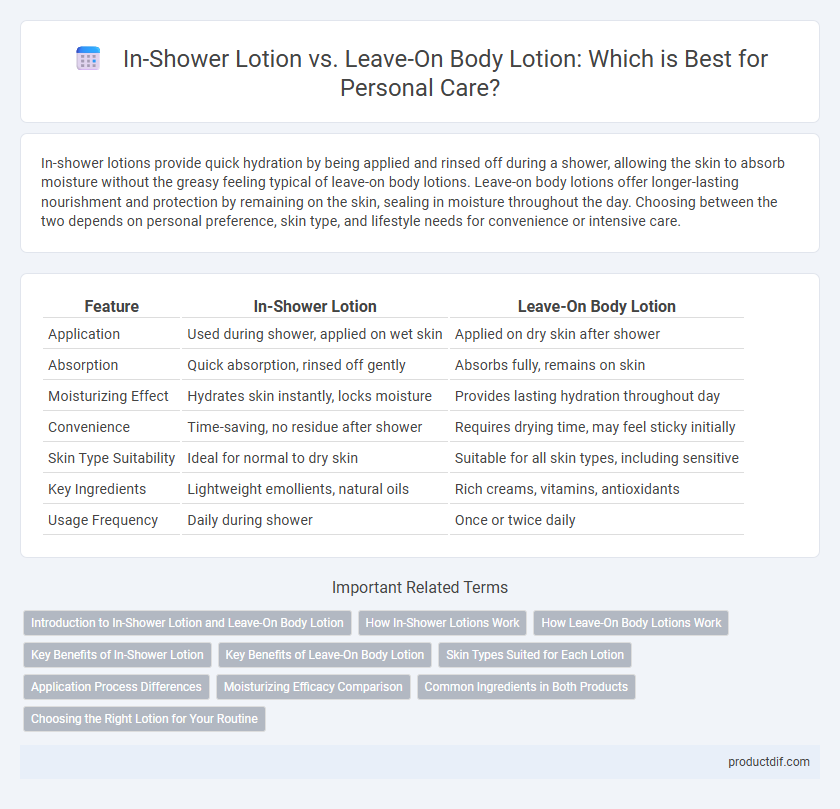In-shower lotions provide quick hydration by being applied and rinsed off during a shower, allowing the skin to absorb moisture without the greasy feeling typical of leave-on body lotions. Leave-on body lotions offer longer-lasting nourishment and protection by remaining on the skin, sealing in moisture throughout the day. Choosing between the two depends on personal preference, skin type, and lifestyle needs for convenience or intensive care.
Table of Comparison
| Feature | In-Shower Lotion | Leave-On Body Lotion |
|---|---|---|
| Application | Used during shower, applied on wet skin | Applied on dry skin after shower |
| Absorption | Quick absorption, rinsed off gently | Absorbs fully, remains on skin |
| Moisturizing Effect | Hydrates skin instantly, locks moisture | Provides lasting hydration throughout day |
| Convenience | Time-saving, no residue after shower | Requires drying time, may feel sticky initially |
| Skin Type Suitability | Ideal for normal to dry skin | Suitable for all skin types, including sensitive |
| Key Ingredients | Lightweight emollients, natural oils | Rich creams, vitamins, antioxidants |
| Usage Frequency | Daily during shower | Once or twice daily |
Introduction to In-Shower Lotion and Leave-On Body Lotion
In-shower lotion is a lightweight moisturizer applied directly onto wet skin during a shower, designed to lock in hydration before rinsing off excess product. Leave-on body lotion, by contrast, is a more concentrated formula intended for application on dry skin, providing longer-lasting moisture and nourishment throughout the day. Both products cater to different skincare preferences and routines, offering customizable hydration solutions based on user needs and time availability.
How In-Shower Lotions Work
In-shower lotions penetrate damp skin by combining hydration from water with moisturizing agents like shea butter and glycerin, locking in moisture immediately after cleansing. Unlike leave-on body lotions, they are rinsed off after application, allowing a thin, non-greasy moisturizing layer that enhances skin softness without residue. This innovative formula supports quick absorption and maintains skin hydration throughout the day, making it ideal for efficient skincare routines.
How Leave-On Body Lotions Work
Leave-on body lotions penetrate deep into the skin to provide long-lasting hydration by locking in moisture and creating a protective barrier against environmental factors. These lotions are formulated with emollients and humectants that attract water to the skin while improving skin texture and elasticity throughout the day. Unlike in-shower lotions, leave-on products remain on the skin, delivering continuous nourishment and enhancing overall skin health.
Key Benefits of In-Shower Lotion
In-shower lotion provides deep hydration by locking in moisture while the skin is still wet, enhancing absorption compared to leave-on body lotions. Its quick-absorption formula saves time and eliminates the greasy residue often associated with traditional lotions. This product is ideal for individuals seeking a convenient, lightweight solution for supple, hydrated skin.
Key Benefits of Leave-On Body Lotion
Leave-on body lotion provides deep hydration by locking in moisture throughout the day, improving skin softness and elasticity with continual use. It delivers essential nutrients and antioxidants that support skin barrier repair and protect against environmental damage. Unlike in-shower lotions, leave-on formulas offer long-lasting protection and nourishment, making them ideal for dry or sensitive skin types.
Skin Types Suited for Each Lotion
In-shower lotions are ideal for normal to dry skin types, providing quick hydration by locking in moisture while the skin is still damp. Leave-on body lotions are better suited for very dry or sensitive skin, offering longer-lasting hydration and additional barrier protection throughout the day. Choosing the right lotion depends on individual skin needs, such as desired absorption rate and moisture retention level.
Application Process Differences
In-shower lotion is applied to wet skin immediately after cleansing and rinsed off quickly, allowing for rapid absorption and hydration without leaving a heavy residue. Leave-on body lotion requires thorough application on dry skin, offering prolonged moisture retention and barrier protection throughout the day. The key difference lies in timing and skin condition during application--wet versus dry skin--which impacts absorption rates and user experience.
Moisturizing Efficacy Comparison
In-shower lotions provide a unique approach to hydration by sealing moisture on damp skin immediately after washing, often containing lightweight formulas rich in humectants and emollients for quick absorption. Leave-on body lotions typically offer deeper and longer-lasting moisturization due to their richer textures and occlusive ingredients that form a protective barrier over dry skin. Clinical studies indicate leave-on lotions generally deliver superior skin hydration, but in-shower products excel in convenience and are ideal for accelerated moisture retention during post-shower routines.
Common Ingredients in Both Products
In-shower lotions and leave-on body lotions commonly contain moisturizing agents such as glycerin and shea butter, which help to retain skin hydration effectively. Both product types often include emollients like jojoba oil and natural extracts such as aloe vera to soothe and nourish the skin. Key shared ingredients also feature humectants and vitamins, including vitamin E, that enhance skin barrier function and promote smoothness.
Choosing the Right Lotion for Your Routine
In-shower lotions provide a quick, water-activated moisturizing option perfect for busy routines or extra hydration after cleansing. Leave-on body lotions offer longer-lasting nourishment and are ideal for targeted skin concerns, such as dryness or eczema, thanks to their thicker formulations. Selecting between the two depends on your skin type and daily habits, ensuring effective hydration without disrupting your routine.
In-shower lotion vs Leave-on body lotion Infographic

 productdif.com
productdif.com